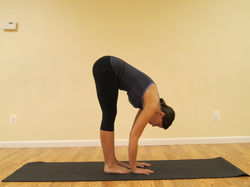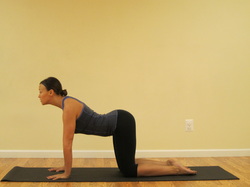 Standing Forward Bend
Standing Forward Bend Yoga poses can be adapted to fit most people’s range of motion. In the next few blogs, I will go over the various adjustments to make yoga poses accessible to almost anyone interested in practicing yoga.
Today, let’s focus on the standing forward bend (uttanasana). You don’t have to reach your toes to benefit from this pose. A simple prop, such as a block placed in front of your feet will serve to raise the floor and let you bend forward, while pressing the hands down into the block.
If you don’t own a block, and can’t yet bring your fingertips or hands to the ground with the legs straight, just hold onto your thighs, shins, or ankles depending on your current flexibility.
How to move into a standing forward bend:
From a standing position, hinge forward from the hips, and bring the chest toward the knees. If the hands can comfortably reach the ground while keeping the legs straight, stay in this position. Otherwise, to modify the pose, choose one of these options: 1) place hands on a block positioned in front of the feet, 2) rest hands on the front of the thighs, 3) rest the hands on the shins, or 4) rest the hands on the ankles.
Caution: If the hands are resting on the legs, avoid pushing the hands back into the knees. Keep the hands on the thighs, shins, or ankles.
Come out of the pose by gently bending the knees, releasing the arms overhead, and returning to a standing position. Then, let the arms rest alongside the torso to bring you back to a mountain pose (tadasana).
Follow us on Facebook and Twitter. For yoga in Dunellen, NJ or yoga in Piscataway, NJ and yoga in other Central New Jersey areas, get in touch with me at Yoga Destiny.
Today, let’s focus on the standing forward bend (uttanasana). You don’t have to reach your toes to benefit from this pose. A simple prop, such as a block placed in front of your feet will serve to raise the floor and let you bend forward, while pressing the hands down into the block.
If you don’t own a block, and can’t yet bring your fingertips or hands to the ground with the legs straight, just hold onto your thighs, shins, or ankles depending on your current flexibility.
How to move into a standing forward bend:
From a standing position, hinge forward from the hips, and bring the chest toward the knees. If the hands can comfortably reach the ground while keeping the legs straight, stay in this position. Otherwise, to modify the pose, choose one of these options: 1) place hands on a block positioned in front of the feet, 2) rest hands on the front of the thighs, 3) rest the hands on the shins, or 4) rest the hands on the ankles.
Caution: If the hands are resting on the legs, avoid pushing the hands back into the knees. Keep the hands on the thighs, shins, or ankles.
Come out of the pose by gently bending the knees, releasing the arms overhead, and returning to a standing position. Then, let the arms rest alongside the torso to bring you back to a mountain pose (tadasana).
Follow us on Facebook and Twitter. For yoga in Dunellen, NJ or yoga in Piscataway, NJ and yoga in other Central New Jersey areas, get in touch with me at Yoga Destiny.


